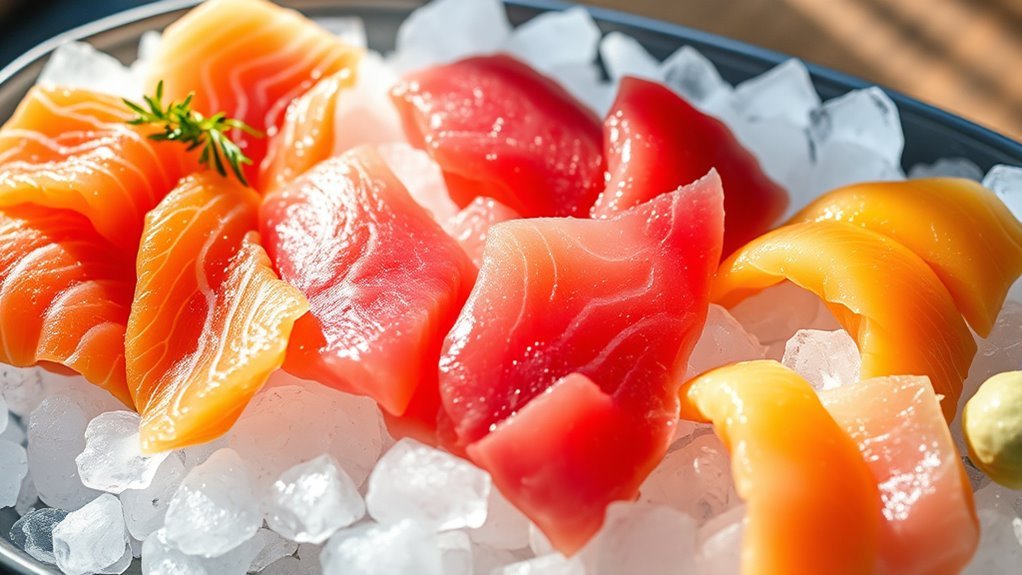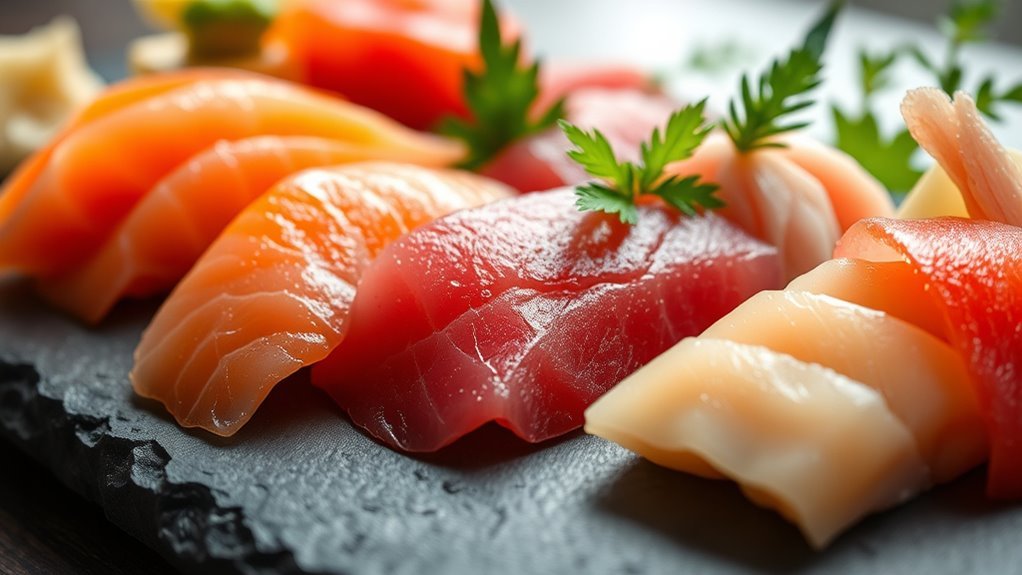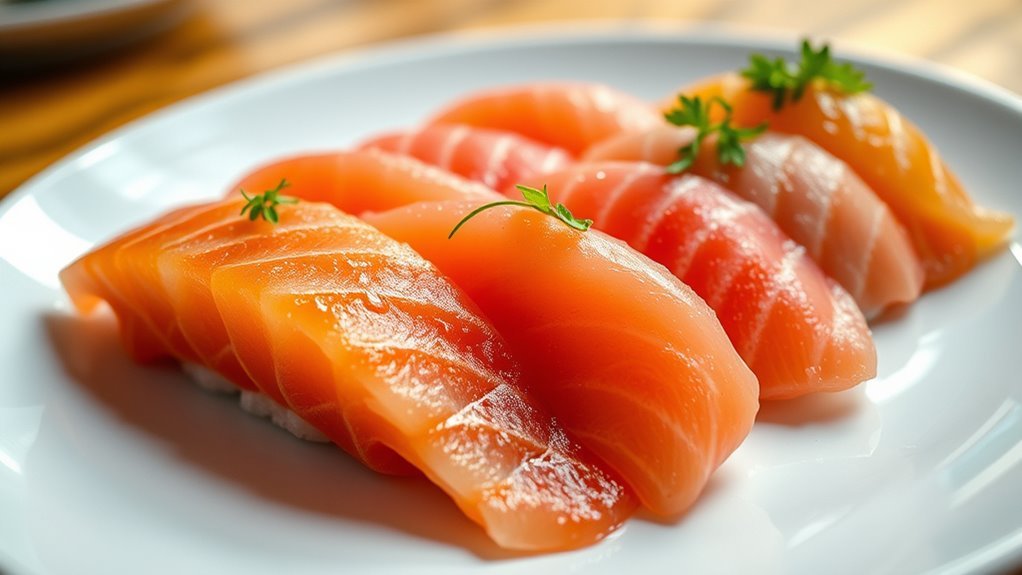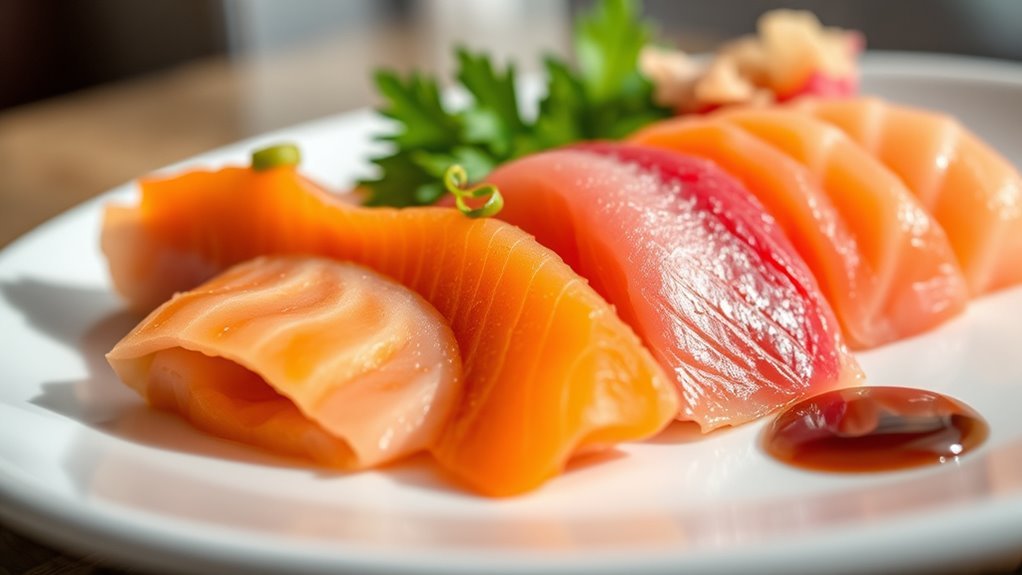Yes, sashimi is definitely keto-friendly! It’s low in carbohydrates, typically containing 0-1g per serving, and is rich in healthy fats and high-quality protein. This makes it a great choice for those following a keto diet. Plus, sashimi provides essential nutrients like omega-3 fatty acids, which support heart health. However, keep in mind potential concerns like sodium content and mercury levels. To learn more about incorporating sashimi into your keto meal plan, there are plenty of delicious ideas to explore!
Understanding the Keto Diet

When you’re exploring dietary options, understanding the keto diet is essential for making informed choices. The keto principles focus on drastically reducing carbohydrates and increasing fats to shift your body’s metabolism into ketosis. This state allows your body to burn fat for energy instead of glucose. Typically, the macronutrient ratios for a keto diet are around 70-75% fats, 20-25% protein, and only 5-10% carbohydrates. This high-fat, low-carb approach not only promotes weight loss but can also enhance mental clarity and energy levels. However, it’s important to choose healthy fats and maintain balanced nutrition. By grasping these fundamentals, you can navigate the keto landscape more effectively and enjoy the freedom of making choices that align with your health goals.
What Is Sashimi?

Sashimi is a Japanese delicacy consisting of thinly sliced raw fish or seafood, often served without rice. You’ll find a variety of ingredients used, from salmon to tuna, each offering unique flavors and nutritional profiles. Understanding its nutritional value and popular varieties can help you decide if sashimi fits into your dietary preferences.
Sashimi Ingredients Overview
Although often associated with sushi, sashimi is a distinct dish that consists primarily of thinly sliced, fresh seafood, typically served without rice. To enjoy sashimi at its best, keep these sashimi freshness tips in mind:
- Choose High-Quality Fish: Opt for fish labeled as “sashimi-grade” to guarantee freshness.
- Serve Immediately: Enjoy sashimi right after it’s prepared to maintain its texture and flavor.
- Pair Wisely: Complement your sashimi with soy sauce, wasabi, and pickled ginger for enhanced taste.
- Presentation Matters: Arrange the slices artistically on a plate, adding garnishes like daikon radish for visual appeal.
These sashimi serving suggestions can elevate your dining experience while allowing you to appreciate the delicate flavors of this dish.
Nutritional Value Breakdown
Understanding the nutritional profile of sashimi can help you appreciate its health benefits. Sashimi is primarily made from raw fish, which is rich in high-quality protein, omega-3 fatty acids, and essential vitamins and minerals. Depending on the type of fish, you can find varying levels of nutrients; for instance, fatty fish like salmon offers more omega-3s compared to leaner options like tuna.
Proper sashimi storage is vital to maintain freshness and prevent spoilage, ensuring you get the maximum nutritional value. During sashimi preparation, minimal processing keeps the nutrients intact, making it a great choice for a keto-friendly diet. With low carbs and high healthy fats, sashimi can be a delicious and nutritious part of your meal plan.
Popular Sashimi Varieties
When diving into the world of sashimi, you’ll discover a delightful array of fish and seafood options that showcase the artistry of Japanese cuisine. Here are some popular sashimi types you might enjoy:
- Salmon (Sake) – Rich in omega-3s, it’s a favorite for its buttery texture.
- Tuna (Maguro) – Known for its meaty flavor, it’s often enjoyed in various cuts.
- Yellowtail (Hamachi) – This fish offers a mild taste and is perfect for sashimi lovers.
- Octopus (Tako) – A unique option, it provides a chewy texture and is often served with a hint of wasabi.
These popular fish not only highlight the diversity of sashimi but also offer a delicious way to enjoy seafood while adhering to a keto-friendly lifestyle.
Nutritional Breakdown of Sashimi

When you consider the nutritional breakdown of sashimi, you’ll find it’s packed with protein, making it an excellent choice for those looking to increase their intake. You’ll also notice that it typically has low fat levels and minimal carbohydrates, which aligns well with keto dietary guidelines. Understanding these components can help you make informed choices about including sashimi in your meals.
Protein Content Analysis
Sashimi, a Japanese delicacy featuring thinly sliced raw fish, offers a rich source of protein that can be a valuable addition to a ketogenic diet. When considering sashimi protein, you’ll find that it provides numerous benefits, making it a great protein source. Here are some highlights:
- High Protein Content: Most types of sashimi contain around 20-25 grams of protein per serving.
- Low in Carbs: Sashimi is virtually carb-free, aligning perfectly with keto principles.
- Essential Amino Acids: It provides all essential amino acids needed for muscle repair and overall health.
- Variety of Options: You can enjoy different fish types, like salmon, tuna, or mackerel, each offering unique nutritional benefits.
Incorporating sashimi into your diet can help you meet your protein needs while staying within your keto goals.
Fat Levels Comparison
While enjoying sashimi, it’s important to contemplate its fat content, as different types of fish can vary considerably in their nutritional profiles. Fat levels can range from lean options like tuna, which has lower fat content, to richer varieties such as salmon and mackerel, packed with omega fatty acids. These omega fatty acids are not only beneficial for heart health but also align well with keto diets. For example, a 3-ounce serving of salmon can provide around 10-15 grams of healthy fats, whereas a similar portion of white fish may contain less than 5 grams. Understanding these differences can help you make informed choices that complement your dietary preferences while enjoying the delightful experience of sashimi.
Carb Count Evaluation
For those following a keto diet, understanding the carb count in sashimi is essential. Sashimi, primarily made from fresh fish, is low in carbohydrates, making it a great choice for keto enthusiasts. Here are some key points to evaluate:
- Most sashimi options contain zero carbs, as fish is not a carb source.
- Certain sauces or accompaniments may add hidden carbs, so be cautious.
- Popular sashimi fish like salmon and tuna are excellent protein sources, enhancing your keto meal.
- Debunking keto myths, sashimi can fit perfectly into your low-carb lifestyle without compromising your goals.
Comparing Sashimi to Other Sushi Options
When you compare sashimi to other sushi options, it’s clear that sashimi offers a distinct nutritional profile, primarily due to its simplicity. Unlike sushi rolls, which often include rice and sauces, sashimi focuses on the fish itself, making it a favorable choice for those seeking low-carb options.
| Sushi Type | Carb Content |
|---|---|
| Sashimi | 0-1g |
| Nigiri | 6-10g |
| Sushi Rolls | 30-50g |
Exploring different sashimi types, like salmon or tuna, can be an exciting culinary adventure. If you’re looking for sushi alternatives, sashimi allows for variety without the added carbs, giving you the freedom to enjoy rich flavors while staying aligned with your dietary goals.
Health Benefits of Sashimi
Sashimi not only stands out for its low carbohydrate content but also offers a range of health benefits that make it a compelling choice for anyone looking to improve their diet. Here’s how sashimi nutrition can enhance your well-being:
Sashimi’s low carbohydrate content and numerous health benefits make it an excellent choice for enhancing your diet.
- High in Protein: Sashimi is packed with quality protein, essential for muscle repair and growth.
- Rich in Omega-3 Fatty Acids: Many fish used in sashimi are loaded with omega-3s, supporting heart health and reducing inflammation.
- Low in Calories: Sashimi is a low-calorie option, making it perfect for weight management.
- Vitamins and Minerals: It provides essential nutrients like vitamin D and selenium, vital for overall health.
Embracing sashimi can be a delicious way to enjoy these health benefits while staying aligned with your dietary goals.
Potential Concerns With Sashimi on Keto
While sashimi is generally a great option for those on a keto diet, there are potential concerns to contemplate. One major issue is the sodium content, which can vary considerably depending on the type of fish and how it’s prepared. High sodium levels can lead to water retention and elevated blood pressure. Additionally, certain fish may contain mercury levels that pose health risks, especially with frequent consumption. Here’s a quick overview:
| Concern | Details |
|---|---|
| Sodium Content | Can vary; check if you’re sensitive to salt. |
| Mercury Levels | Higher in larger fish like tuna and swordfish. |
| Frequency of Consumption | Moderation is key to minimize risks. |
| Preparation Methods | Raw vs. marinated can affect sodium intake. |
Being aware of these factors helps you enjoy sashimi responsibly.
How to Incorporate Sashimi Into Your Keto Meal Plan
Incorporating sashimi into your keto meal plan can be a delicious and nutritious choice, especially since it’s low in carbs and high in healthy fats and protein. Here’s how you can enjoy sashimi while staying on track with your keto goals:
- Choose Fresh Fish: Opt for fatty fish like salmon or mackerel for the best health benefits.
- Experiment with Sashimi Toppings: Add avocado, sesame seeds, or seaweed for extra flavor and healthy fats.
- Select Keto-Friendly Dipping Sauces: Use soy sauce, wasabi, or a low-carb ponzu to enhance taste without adding carbs.
- Pair with Low-Carb Sides: Consider a side of cucumber salad or zucchini noodles for a complete meal.
Enjoy the freedom of delicious, satisfying meals with sashimi!
Delicious Sashimi Recipes for Keto Enthusiasts
If you’re looking to elevate your keto diet with flavorful options, delicious sashimi recipes can be a fantastic addition. Think about pairing fresh fish like salmon or tuna with homemade sashimi sauces for a burst of flavor without the carbs. A simple soy sauce or a spicy mayo made with avocado oil can enhance your meal while keeping it keto-friendly. Don’t forget about keto dips! A creamy avocado dip or a tangy cilantro-lime dip can add a rejuvenating twist. Experimenting with different sashimi types and toppings, like sesame seeds or seaweed, can keep your palate excited. With these easy recipes, you’ll enjoy the freedom of delicious, satisfying meals that fit perfectly into your keto lifestyle.
Frequently Asked Questions
Can I Eat Sashimi Every Day on a Keto Diet?
They say, “Variety is the spice of life,” and that’s essential for daily meal planning. Eating sashimi every day can be beneficial, as it’s low in carbs and packed with protein and omega-3 fatty acids. However, relying solely on sashimi might lead to nutrient deficiencies. Balance is key; incorporate other foods for essential vitamins and minerals. Enjoy sashimi’s health benefits, but mix it up to keep your diet vibrant and sustainable!
What Types of Fish Are Best for Keto Sashimi?
When choosing fish varieties for sashimi, you’ll want to focus on those that are low in carbs and high in healthy fats. Salmon, mackerel, and tuna are excellent choices, as they provide omega-3 fatty acids while keeping your carb intake minimal. Other sashimi types, like yellowtail and sardines, can also be great options. Incorporating these fish into your diet can support a keto lifestyle while allowing for delicious, fresh meals.
Is Sashimi Safe to Eat Raw on Keto?
Eating raw fish can be safe, especially if it’s sourced from reputable suppliers. On a keto diet, sashimi offers several benefits, including low carbs and high protein, making it a great option for maintaining ketosis. Just guarantee you’re aware of the freshness and quality of the fish to minimize health risks. Embracing freedom in your dietary choices means enjoying delicious options like sashimi while being mindful of safety.
How Much Sashimi Can I Eat on Keto?
When considering how much sashimi you can eat on keto, it’s essential to stick to portion sizes that align with keto guidelines. Generally, a serving of sashimi is about 3 to 4 ounces, which provides healthy fats and protein without excessive carbs. You can adjust your intake based on your overall daily macro goals, but enjoying sashimi in moderation allows you to savor its flavor while staying within your dietary freedom.
Does Sashimi Contain Added Sugars or Carbs?
Imagine savoring delicate slices of fresh fish, the ocean’s bounty on your plate. When you consider sashimi, it’s usually just raw fish, like salmon or tuna, which are low in carbs. Most sashimi ingredients don’t contain added sugars, keeping their nutritional values clean. However, be wary of sauces or marinades, as they can sneak in hidden carbs. Enjoy sashimi freely, but always check for those extra ingredients that might weigh you down!


